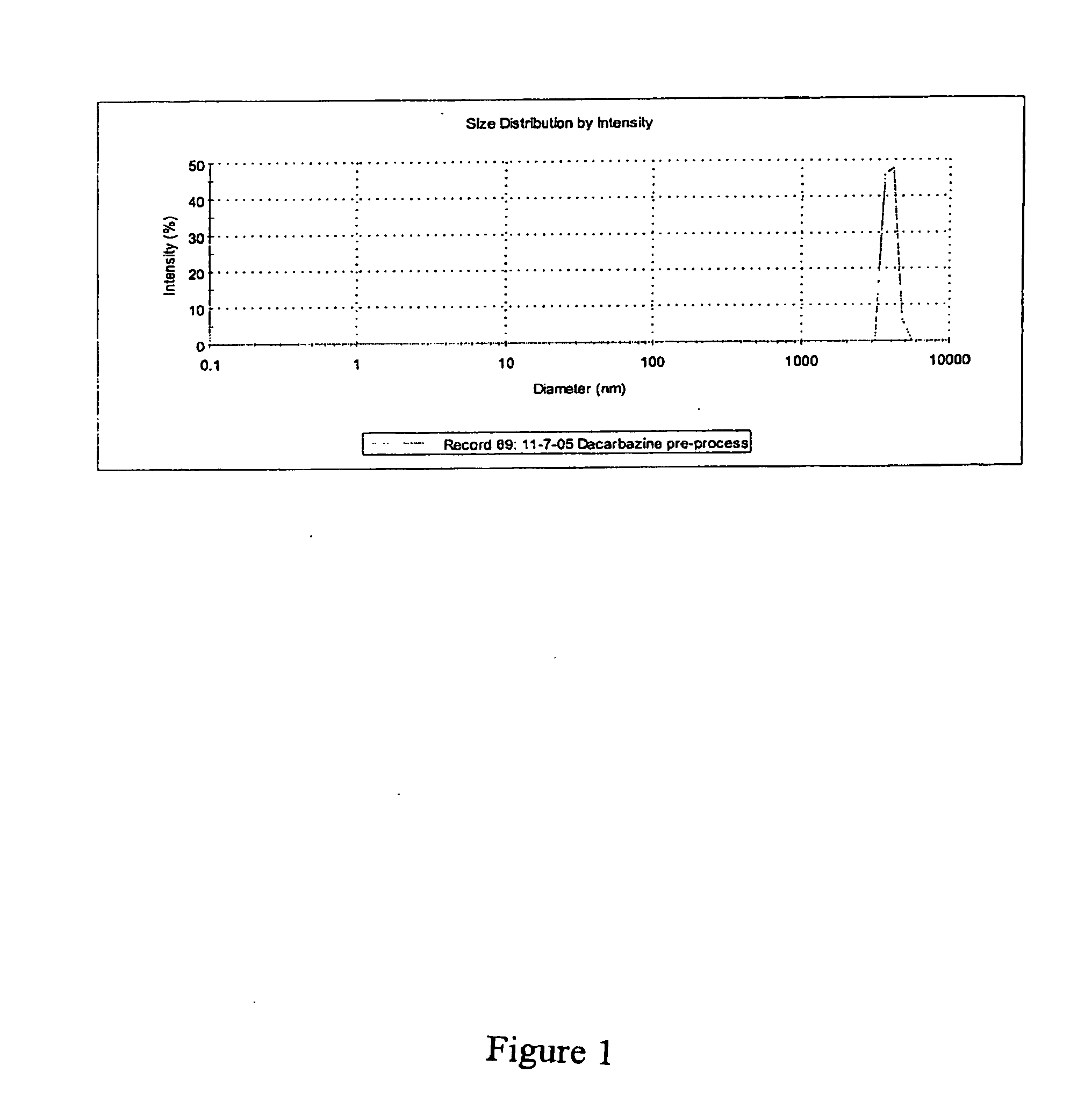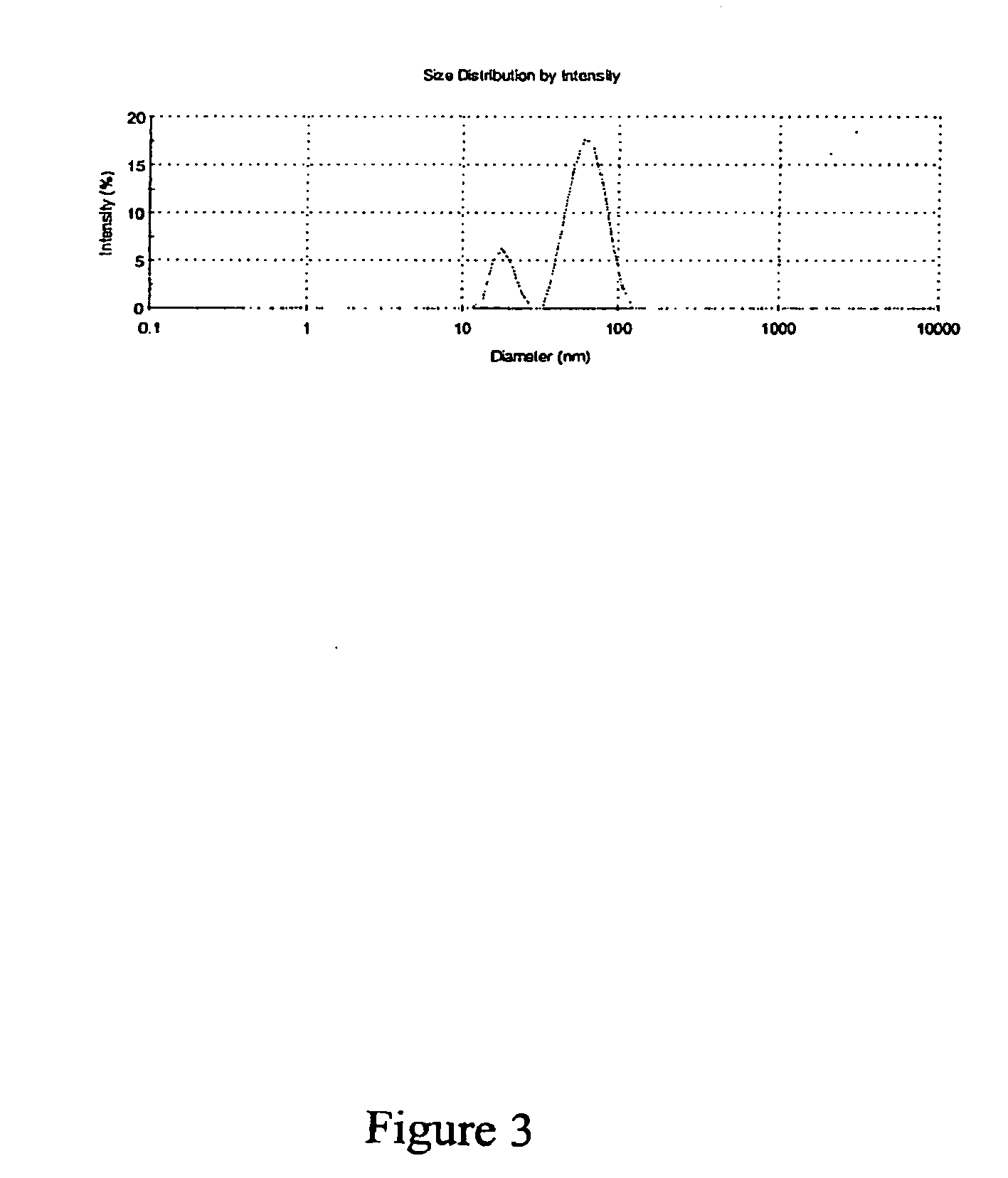Compositions and methods for treating cancer with dacarbazine nanoemulsions
- Summary
- Abstract
- Description
- Claims
- Application Information
AI Technical Summary
Benefits of technology
Problems solved by technology
Method used
Image
Examples
example 1
Dacarbazine Microfluidized Nanoemulsions
[0187]This example presents one dacarbazine embodiment of a microfluidized nanoemulsion. The basic step-wise procedure is as follows using the following compounds: i) dacarbazine (3×10−3M) MW=182.2; ii) soybean oil (Density—0.917 g / ml); iii) polysorbate 80 (Density—1.064 g / ml); and water.[0188]1. Heat soybean oil.[0189]2. Add dacarbazine, stir and heat 10 mins[0190]3. Add polysorbate 80 to soybean / dacarbazine solution.[0191]4. Heat de-ionized water to 70° C.[0192]5. Add soybean / dacarbazine solution to heated de-ionized water, heat at 70° C. while stirring for 30 mins.[0193]6. Homogenize Step 5 mixture for 2-4 mins[0194]7. Stir Step 6 homogenate for 10 mins on hot plate[0195]8. Microfluidize Step 7 homogenate using a M-110EH unit at 25,000 PSI (single pass).[0196]9. Do particle diameter analysis using a Malvern Nano S instrument
[0197]Before microfluidization the dacarbazine mixture comprised an average particle size of approximately 3643 nm. Se...
example 2
Stable Formulation of Cod Liver Oil Microfluidized Nanoemulsions
[0199]This example presents one cod liver oil embodiment of a microfluidized nanoemulsion that has a stable particle diameter for at least four months. The step-wise procedure is as follows:
[0200]1. Heat 5 g of soybean oil (65° C.)
[0201]2. Add 5 g cod liver oil, stir and heat to 80° C.
[0202]3. Add 6 g polysorbate 80, stir and heat 20 mins
[0203]4. Add 200 mL de-ionized water, stir and heat 30 mins
[0204]5. Microfluidize using a M-110EH unit once at 25,000 PSI
[0205]6. Do particle diameter analysis using a Malvern Nano S instrument
[0206]The mean particle diameter (i.e., Peak 1 / Peak 2) for this cod liver oil microfluidized nanoemulsion was 58 nm (data not shown). Before microfluidization, the mean particle diameter of the cod liver oil suspension was 2,842 nm. This represents a 50-fold reduction with a single pass through the microfluidizer. Four months after the microfluidization process, the particle diameter was again det...
example 3
Stable Formulation of Tocopherol Microfluidized Nanoemulsions
[0207]This example presents one tocopherol embodiment of a microfluidized nanoemulsion that maintains particle diameter for at least five months. The step-wise procedure is as follows:
[0208]1. Heat 13.5 g of soybean oil
[0209]2. Add 2 g tocopherol, stir and heat to 90° C.
[0210]3. Heat 2 g polysorbate 80 in 100 mL de-ionized water, heat to 75° C.
[0211]4. Add step 3 mixture to step 2 mixture
[0212]5. Heat 300 mL di-ionized water and 6 g polysorbate 80, heat till 70° C.
[0213]6. Add step 4 mixture to step 5 mixture, keep stir bar and heat on
[0214]7. Homogenize step 6 mixture for 2-4 mins
[0215]8. Stir formulation for 3-5 mins on hot plate
[0216]9. Microfluidize using a M-110EH unit once at 25,000 PSI
[0217]10. Do particle diameter analysis using a Malvern Nano S instrument
[0218]The mean particle diameter for the tocopherol microfluidized nanoemulsion was 64 nm (data not shown). Before microfluidization, the mean particle diameter f...
PUM
| Property | Measurement | Unit |
|---|---|---|
| Diameter | aaaaa | aaaaa |
| Size | aaaaa | aaaaa |
| Size | aaaaa | aaaaa |
Abstract
Description
Claims
Application Information
 Login to View More
Login to View More - R&D
- Intellectual Property
- Life Sciences
- Materials
- Tech Scout
- Unparalleled Data Quality
- Higher Quality Content
- 60% Fewer Hallucinations
Browse by: Latest US Patents, China's latest patents, Technical Efficacy Thesaurus, Application Domain, Technology Topic, Popular Technical Reports.
© 2025 PatSnap. All rights reserved.Legal|Privacy policy|Modern Slavery Act Transparency Statement|Sitemap|About US| Contact US: help@patsnap.com



